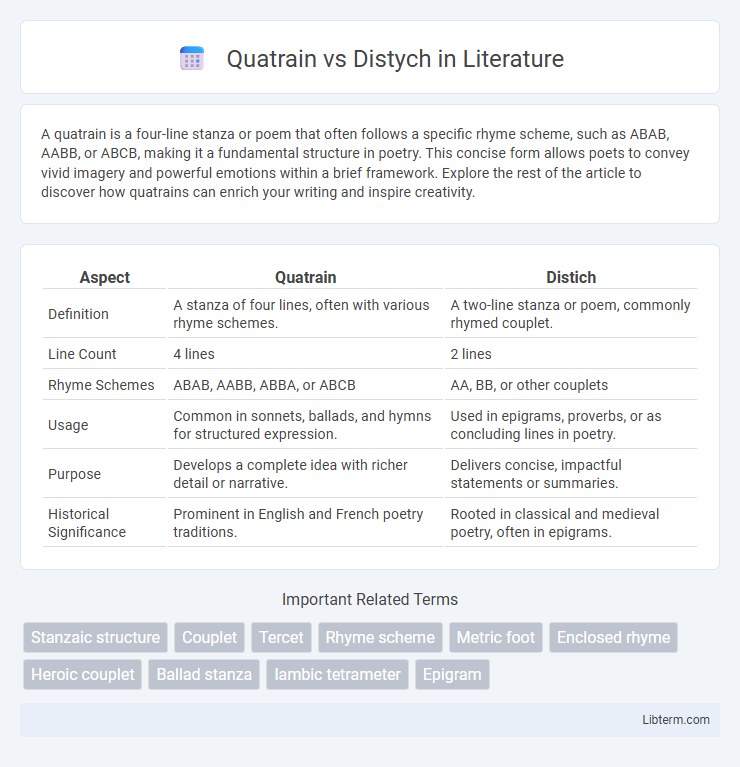A quatrain is a four-line stanza or poem that often follows a specific rhyme scheme, such as ABAB, AABB, or ABCB, making it a fundamental structure in poetry. This concise form allows poets to convey vivid imagery and powerful emotions within a brief framework. Explore the rest of the article to discover how quatrains can enrich your writing and inspire creativity.
Table of Comparison
| Aspect | Quatrain | Distich |
|---|---|---|
| Definition | A stanza of four lines, often with various rhyme schemes. | A two-line stanza or poem, commonly rhymed couplet. |
| Line Count | 4 lines | 2 lines |
| Rhyme Schemes | ABAB, AABB, ABBA, or ABCB | AA, BB, or other couplets |
| Usage | Common in sonnets, ballads, and hymns for structured expression. | Used in epigrams, proverbs, or as concluding lines in poetry. |
| Purpose | Develops a complete idea with richer detail or narrative. | Delivers concise, impactful statements or summaries. |
| Historical Significance | Prominent in English and French poetry traditions. | Rooted in classical and medieval poetry, often in epigrams. |
Introduction to Quatrains and Distychs
Quatrains and distychs are fundamental poetic structures characterized by their line counts and rhyme schemes: quatrains consist of four lines typically following patterns like ABAB or AABB, while distychs comprise two lines often forming a complete thought or epigram. Quatrains offer versatility in rhythm and thematic development, prominent in various poetic traditions such as Shakespearean sonnets and ballads. Distychs emphasize brevity and impact, commonly used in classical epigrams and elegies, highlighting the contrast in length and functional expression between these two poetic forms.
Definition of Quatrain
A quatrain is a stanza or poem consisting of four lines, often following a specific rhyme scheme such as ABAB, AABB, or ABBA, and is commonly used in various forms of poetry including sonnets and hymns. In contrast, a distich is a two-line stanza or couplet that typically expresses a complete thought or idea. Understanding the quatrain's structure and rhyme patterns highlights its role in creating rhythm and thematic development within longer poetic works.
Definition of Distych
A distych is a poetic form consisting of two lines, often forming a complete thought or epigram. Unlike a quatrain, which has four lines and can follow various rhyme schemes, a distych is concise and traditionally used in classical poetry to convey brief, impactful messages. This compact structure emphasizes clarity and wit in a minimal format.
Historical Background of Quatrains
Quatrains, composed of four lines with distinct rhyme schemes such as ABAB or AABB, have roots tracing back to ancient Persian and classical Arabic poetry, where they were used extensively in forms like the Rubaiyat. This poetic structure gained prominence in European literature during the medieval period, notably in the works of Geoffrey Chaucer and later in English Renaissance poetry. Quatrains became a fundamental unit in various poetic forms, distinguished from the distych's two-line structure, offering greater complexity and rhythmic versatility.
Historical Background of Distychs
Distichs, also known as couplets, have their origins in ancient Greek and Latin poetry, where they were frequently used in elegiac and epigrammatic compositions. This poetic form consists of two lines, often with contrasting or complementary ideas, tracing back to classical poets such as Callimachus and Ovid. The simplicity and brevity of distichs made them a popular structure for concise, impactful expressions throughout classical antiquity and the Roman literary tradition.
Structural Differences: Quatrain vs Distych
A quatrain consists of four lines with a specific rhyme scheme, typically ABAB, AABB, or ABCB, while a distych comprises only two lines that often form a complete thought or expression. The quatrain's structure allows for more complex rhythmic and thematic development, whereas the distych's brevity emphasizes conciseness and impact. These structural differences influence their use in poetry, with quatrains common in narrative and lyrical forms and distyches frequently employed in epigrams and aphorisms.
Common Themes and Usage
Quatrains and distichs often explore themes such as love, nature, and morality, with quatrains providing a more complex framework for developing ideas through four lines. Distichs, composed of two lines, offer concise expressions typically found in epigrams, proverbs, and epitaphs, emphasizing brevity and impact. Both forms appear in classical and modern poetry, serving distinct purposes in conveying emotion, reflection, or narrative within various literary traditions.
Notable Examples in Literature
Quatrains appear prominently in William Shakespeare's sonnets, where the four-line stanzas create rhythmic patterns essential to the poems' structure and emotional impact. Distichs are famously used in the works of the ancient Roman poet Horace, particularly in his Odes, where two-line verses convey concise and profound philosophical insights. Both forms are integral to the evolution of poetic expression, with quatrains dominating English lyric poetry and distichs influencing classical and Latin literary traditions.
Advantages and Limitations of Each Form
Quatrains offer structural flexibility with four lines that can follow varied rhyme schemes, making them ideal for narrative and descriptive poetry, while their length allows for more detailed expression but can sometimes dilute impact. Distichs, consisting of two lines, provide a concise and powerful delivery often used for epigrams or aphorisms, offering clarity and emphasis yet limiting thematic development. The choice between quatrain and distich balances complexity and brevity, influencing the poem's rhythm and emotional intensity.
Choosing Between Quatrain and Distych: When and Why
Choosing between a quatrain and a distych depends on the desired poetic structure and thematic emphasis; a quatrain, with its four-line stanzas, offers more space for developing complex ideas and varied rhyme schemes, making it ideal for narrative or descriptive poetry. Distychs, composed of two-line stanzas or couplets, provide a concise and impactful format suited for aphorisms, epigrams, or poignant reflections. Understanding the poem's purpose and rhythm can guide poets in selecting the appropriate form to enhance clarity and emotional resonance.
Quatrain Infographic

 libterm.com
libterm.com